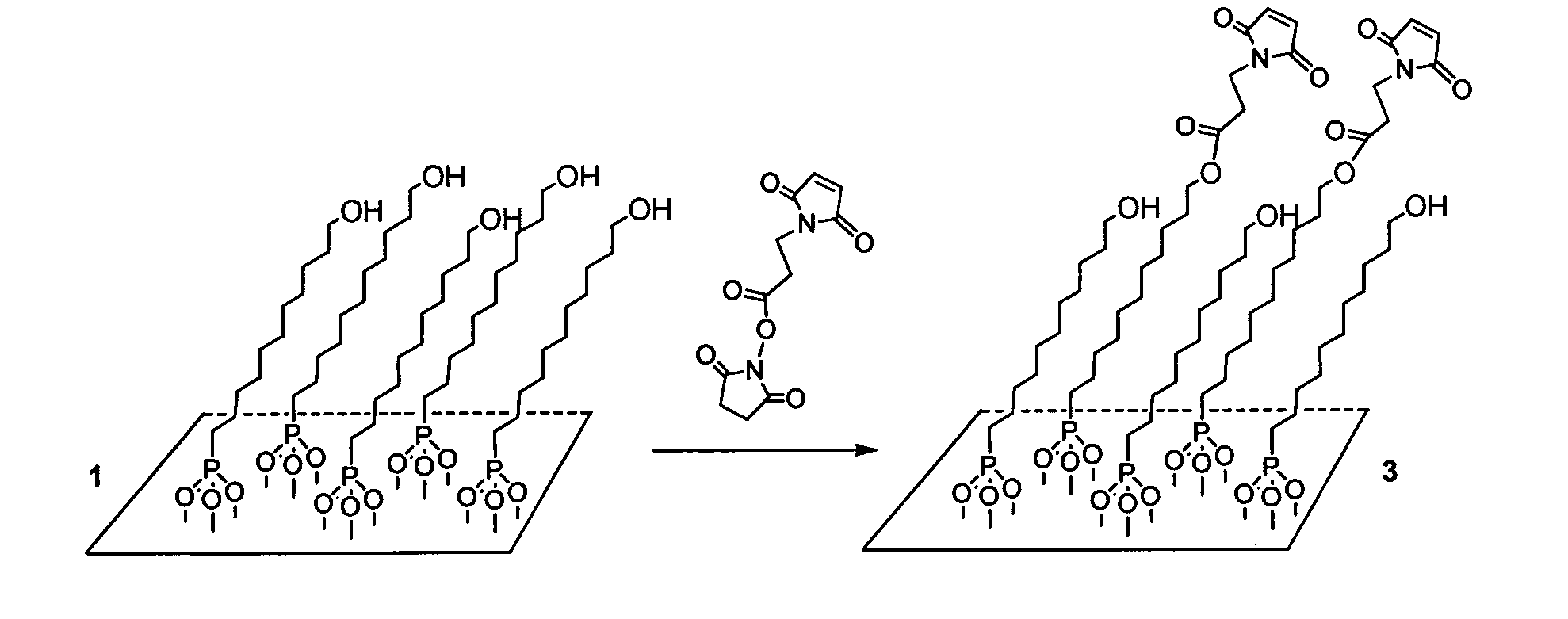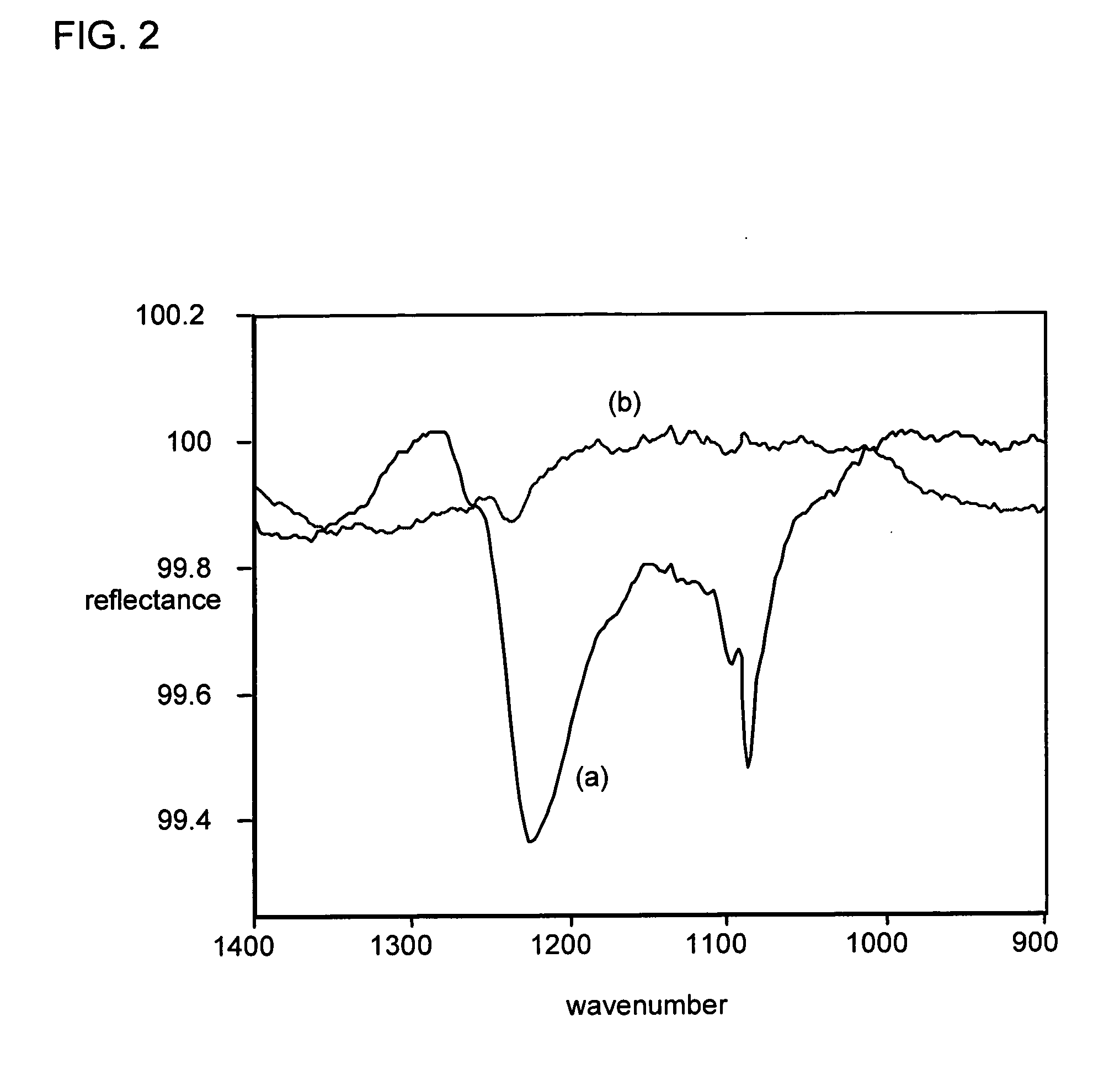Devices with multiple surface functionality
a technology of multiple surface functionality and devices, applied in the field of devices with multiple surface functionality, can solve the problems of blood thrombosis, increased inflammation, and decreased healing ra
- Summary
- Abstract
- Description
- Claims
- Application Information
AI Technical Summary
Benefits of technology
Problems solved by technology
Method used
Image
Examples
examples 1-3
[0188] For the following Examples 1-3, ethanol (reagent grade) was obtained from Aldrich Chemical and used as received. 11-Hydroxyundecylphosphonic acid (a linear, 11-carbon-atom difunctional phosphonic acid having an ω-hydroxyl functional group to the phosphonic acid) was synthesized according to published procedures. Disks were cut from titanium Ti-6Al-4V rod (1′ in diameter, obtained from Goodfellow, Inc.) and prepared for use by sanding, followed by cleaning with methanol. The disks were dried for at least an hour before use, and stored in an oven at 200° C.
[0189] Samples were analyzed using either a Nicolet 730 FT-IR equipped with a Spectra Tech diffuse reflectance (DRIFT) attachment or a MIDAC Illuminator equipped with a Surface Optics specular reflectance head. When the Nicolet was used for analysis, infrared experiments were performed using a glancing angle attachment, a Variable Angle Specular Reflectance Model 500, obtained from Spectra Tech. The angle between the surface...
example 1
Application of a Coating Layer
[0190] A white cotton swatch of commercial textile measuring 2′ square was prepared as a carrier by rinsing in distilled water and drying in air. A 1.0 millimolar coating solution of 11-Hydroxyundecylphosphonic acid was prepared by dissolving 0.1 mM of the acid in 100 ml of ethanol. About 50 ml of the solution was placed in a shallow dish and the carrier was placed into the solution and saturated with it. The carrier was then removed from the solution and permitted to remain in air until it was visibly dry (overnight). Thus prepared, the carrier with containing a coating composition comprising 11-Hydroxyundecylphosphonic acid was placed over a titanium disk prepared as described above. A consumer cloth iron with a Teflon™-coated heating platen (Black & Decker) set for cotton cloth (no steam) was placed on top of the assembly for a period of 5 minutes. At the end of the heating period the iron was removed and the oxide substrate (titanium disk) was allo...
example 2
Deposition of a Coating Layer on a Metal Oxide Coated Plastic
[0193] A sheet of antireflective coated polyethylene oxide terephthalate (PET) which has a top layer of silicon dioxide will be obtained from Bekaert Specialty Films. Application of a cotton carrier prepared with a coating composition, as described above for Example 1, in accordance with the treatment procedure described above for Example 1 will be found to provide an 11-hydroxyundecylphosphonate coating to the antireflective coated plastic.
PUM
| Property | Measurement | Unit |
|---|---|---|
| thickness | aaaaa | aaaaa |
| thickness | aaaaa | aaaaa |
| thickness | aaaaa | aaaaa |
Abstract
Description
Claims
Application Information
 Login to View More
Login to View More - R&D
- Intellectual Property
- Life Sciences
- Materials
- Tech Scout
- Unparalleled Data Quality
- Higher Quality Content
- 60% Fewer Hallucinations
Browse by: Latest US Patents, China's latest patents, Technical Efficacy Thesaurus, Application Domain, Technology Topic, Popular Technical Reports.
© 2025 PatSnap. All rights reserved.Legal|Privacy policy|Modern Slavery Act Transparency Statement|Sitemap|About US| Contact US: help@patsnap.com



